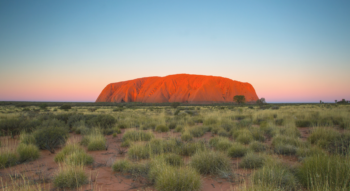Episode Notes
As the housing crisis worsens, do we have the courage to reimagine a home among the gumtrees or are we too set in our ways to branch out? In this episode, we investigate why density is a dirty word and offer a comprehensive view of the possibilities ahead. Join host Ginger Gorman as she speaks to housing policy expert Professor Bill Randolph (UNSW City Futures Research Centre), innovative architect Lisa Garner from LIAN Architects, and Associate Professor in Urban Planning (The University of Queensland), Dr Dorina Pojani, to break ground on the problem and reimagine our cities.
Transcript
Ginger Gorman (00.01):
What sort of home did you grow up in? I’m talking about the literal bricks and mortar. Was it a three-bedroom on a big, grassy block in the suburbs, or was it an apartment in a capital city?
Professor Bill Randolph (00.12):
We are well known as a country of big cities. They have been very low-density in the past, and I think there’s still a longstanding regard for the idea of having a single-family home on a block of land, where you can shut the door and not be interfered with.
Ginger Gorman (00.31):
Professor Bill Randolph is a member of the City Futures Research Centre at the University of New South Wales, and he’s a Fellow of the Academy of the Social Sciences in Australia. Where you grew up and the kind of house you lived in has probably shaped your choice of home as an adult. If you’ve been lucky enough to have a choice, that is. So, if you grew up in a neighborhood that was close to the city, but still had a backyard big enough for a Hills Hoist and a game of cricket, maybe that’s what you want for your family as well.
Professor Bill Randolph (01.02):
That’s long gone in real terms. Certainly, over the last 20, 30 years, you will not find a standard quarter-acre block being developed in an Australian city, but it’s up there in people’s minds. I think the other side of it, of course, is then the threat of density coming to a garden near you, is something which gets a pretty visceral reaction from many people.
Ginger Gorman (01.27):
The Great Australian Dream has shifted. A few decades ago, 55% of people in their 20s and 30s were homeowners. Now, that’s closer to 40%, but it’s not only homeownership that’s becoming unachievable for young adults. Finding an affordable rental in a capital city these days is gruelling, and it has only gotten harder since the pandemic. In the first quarter of 2023, Australia’s population was nearly 26.5 million people, and our annual growth rate was 2.2%. That’s around an extra 563,000 people every year through natural increase and migration. But density is still a dirty word.
Dr Dorina Pojani (02.15):
I think it’s actually the fear of the unknown.
Ginger Gorman (02.18):
Dorina Pojani is an Associate Professor in Urban Planning at the University of Queensland.
Dr Dorina Pojani (02.23):
How many people in Australia actually have the experience of living in a high-density setting? Not very many. Most people have grown up in a suburb, in a single-family home with a little patch of a garden, and that’s the experience they have. So, they don’t know that density could actually be very beautiful and vibrant. In a high-density setting, you might be able to meet your neighbors more rather than less. Also, you may be able to have high-quality public transport, which we don’t have in many places in Australia at the moment.
Ginger Gorman (03.02):
How do we get density right, so that the people who need a home can access something that’s both affordable and livable, and the people who already have a home don’t feel quite so uneasy that their Great Australian Dream might become their worst nightmare? This is Seriously Social, I’m Ginger Gorman. Today on the podcast, we have a housing crisis in this country. The question is, will we as Australians sacrifice our low-density suburban lifestyle to help solve it? Why is ‘density’ such a dirty word in Australia? Here’s Professor Bill Randolph, again.
Professor Bill Randolph (03.56):
At the base, I guess it’s about a threat to your assets and your lifestyle.
Ginger Gorman (04.03):
Ideologically, many people have a problem with high-density living. On a practical level, there are a lot of problems associated with low-density developments.
Professor Bill Randolph (04.13):
Low-density suburbanisation has been linked to congestion, expensive infrastructure rollout, and who pays for it, which is pretty critical. Issues around sustainability. The single-family home is seen as an unsustainable way of carrying on, particularly the very large McMansions-type housing we’ve seen recently, very energy-intensive and so on. Higher-density housing is seen to be better for people because it means you can walk around the place, as opposed to drive everywhere. And of course, it improves, we’re told, accessibility to existing transportation routes, particularly trying to get that shift away from extensive car use into the use of public transport.
(04.59):
So, there’s been a big push in the last 20 years, particularly in Australia and elsewhere, to build around transport corridors and transport nodes. Transport-orientated development, it’s basically called. There are counters to that. That in a sense, building high-rise towers made out of concrete, steel, glass and so on, there’s a lot of energy goes into building them. Yes, they are potentially more walkable, but quite a lot of the outcomes that we’ve seen around us don’t appear to be particularly appealing. They’re not the sort of walkable neighborhoods we tend to associate with the density you get in European cities, for example. So, we haven’t quite produced the sort of densification that the planners and others would like to see.
Ginger Gorman (05.47):
Where are we going wrong then? What is stopping Australian cities from growing up instead of sprawling out?
Professor Bill Randolph (05.53):
I do think there’s an issue here about how we’ve done densification. A lot of it leaves a lot to be desired. I think that’s one of the problems, and we’re not really importing the European-style density which you get in Amsterdam, which looks very nice and it’s been there for a long time. We’re getting something else, very much of an Australian type of densification, which again, has problems.
Ginger Gorman (06.16):
I know your work looks a lot into the idea of getting density right. I’m just thinking as you’re talking, that in cities like Amsterdam where I’ve lived, it’s very bicycle-friendly, it’s very public-transport friendly. All of those lifestyle aspects are woven into the high density. So in fact, it doesn’t negatively impact your lifestyle.
Professor Bill Randolph (06.40):
No, that’s because Amsterdam was built in that way for that mode of transport. Australian cities, other than the very downtown areas which grew out 150 years ago, have been built around car transport. So, you’ve got a very different urban form there. It’s all very well to say Amsterdam’s a fantastic place to live. It is a very pleasant place to live, but it’s not a 21st-century city. It’s an 18th-century city, possibly a little bit older. It was built in a different time for a different context than that. It’s flat, as well. So, cycling around, walking around in that sort of area is quite feasible. It’s very difficult to retrofit an Amsterdam-style city back into a 21st-century Australian city. A lot of it is to do with the way in which we own and divide the land underneath it. The land ownership patterns in places like Amsterdam date back many years, many decades. Here, we have a very different land ownership system, and a lot of what we see is driven by the requirements of the development industry to do profitable development.
Ginger Gorman (07.56):
Bill says most housing in Australia falls into either low-density or high-density, but there’s a missing middle.
Professor Bill Randolph (08.04):
Three-story walkups, four-story walkups, which just don’t get built anymore, because the development industry finds it much more profitable to build as high as possible on whatever piece of land they can get. So, I think the polarisation between that sort of low-density, old-style sprawl in some respects… although it is denser than the previous sprawl, I have to say… and that much higher-density, inner-city renewal, is what’s squeezed out the missing middle.
(08.34):
There’s a very strong argument that the missing middle is actually what people want. If you want to downsize and you’re living in a low-density suburb, there really isn’t much anywhere to go apart from to try and get a two-bedroom flat in a tower block. That’s a critical thing. The way in which the development industry works, the consolidation of ownership in that industry, the squeezing out of the smaller developer who would be good to develop that missing middle, is one of the problems we have today. The planning industry, of course, has promoted that.
Ginger Gorman (09.11):
If we know that some people want to live in medium-density developments, why doesn’t the market meet that demand?
Professor Bill Randolph (09.19):
I think there’s a myth that somehow housing, like almost anything, really, is suddenly driven by some consumer demand, which suddenly demands certain products. The high-density industry in Australia, as elsewhere actually, is pretty much driven by an investor market. Now, this is something which we don’t often talk about, but 60%, 70% of apartments that sold in the last decade have probably been sold to investors, not to individuals who have bought it for themselves to live in.
Ginger Gorman (09.49):
If the people who are developing and buying high-density apartments are never going to live in them, what does this mean for the renters and investors in the long run?
Professor Bill Randolph (09.59):
I think there are places where there’s going to be a rapid turnover of rental tenants over time, landlords themselves may get disincentivised to invest in the properties. So, we’re going to get a potential down the track, if we’re not careful, for a devalued very-high-density sector. Then, you’ve got to think through, “Well, what are we going to replace it with? How are we going to replace it, and who’s going to replace it in 30, 40, 50 years’ time?” I don’t think we’ve thought that one through at all at this stage.
Ginger Gorman (10.35):
But there are groups, maybe not on the policymaking level, but smaller, local groups thinking a lot about how best to replace bad housing. In Melbourne, there’s Nightingale Housing, a not-for-profit that’s been building socially, financially, and environmentally sustainable apartments. Architect Lisa Garner has been working on one of their projects.
Lisa Garner (10.58):
It’s about getting residents together and building apartments with an intentional group of people. They talk a lot about community size, something not more than four apartments per level, and not more than six storeys. And, about having a certain number of residents, so that the common areas in the building, whether they’re on the rooftop or on the ground, do get used well, and there’s a sweet spot in terms of people to take ownership of those common areas, but also just the right number of people to not feel like strangers.
Ginger Gorman (11.27):
Lisa Garner’s passion for nailing medium-density housing comes from her experience of living in Berlin.
Lisa Garner (11.34):
I think it made me optimistic about density, and see the positive side of living a bit closer to other people. Having that sense of community, even within a development, specifically the apartments in Berlin, what I realised was there’s nothing radically exceptional about them. It’s really just the way that they’re planned, to get good natural light, the high ceilings, it feels more generous, and that’s it. The natural light, ventilation, good floor plan, high ceilings, is kind of all you need to create really good housing.
Ginger Gorman (12.11):
Sounds simple enough. So, again I ask, what’s stopping us? There are lots of challenges.
Lisa Garner (12.19):
The first one is planning rules and regulations. For a long time, planning codes have been supporting just subdivision. The easiest thing for an owner-builder to do is subdivide into two or three townhouses, which is some density, but it’s not enough, and the outcomes are somewhat suboptimal, like half the side is a driveway to fit two or three private garages, and there’s not great amenity in terms of landscape. That has a lot to do with the planning rules.
Ginger Gorman (12.48):
As Lisa acknowledges, our homes are precious, emotionally and financially.
Lisa Garner (12.54):
Australian residents having the right to object to developments that are happening around them is, obviously it’s a good thing that we’re able to, in a democracy, have a say about the developments going in around us, but it definitely makes it a lot harder for medium-density housing. Because, people are very precious with their homes and their land, and there’s a lot of resistance to having anything higher-density going up around you because of the perceived impact.
Ginger Gorman (13.19):
In 2020, when Lisa returned from Berlin and was living in Melbourne, she and a friend, Andrej Vodstrcil, were one of the winning entrants in a Victorian State Government Future Homes Competition. It was a chance to propose a more sustainable way for housing.
Lisa Garner (13.37):
It wasn’t just that we were designing typology so it was suited to middle-ring suburban blocks. We were also involved in a planning scheme amendment.
Ginger Gorman (13.46:
The idea was that they published their designs online, available for builders, developers, and housing providers to buy, and go through a more streamlined approval process, reducing appeals.
Lisa Garner (13.58):
Essentially, you’re demonstrating that you are delivering this sort of high-quality, medium-density apartment building, and therefore you are removing some of the obstructions which can come your way in terms of getting planning approval.
Ginger Gorman (14.11):
It’s interesting, you talk about planning.
Lisa Garner (14.13):
Yep.
Ginger Gorman (14.13):
Because, I’m wondering if there’s a piece before that, which is actually changing our national psychology-
Lisa Garner (14.19):
Yep.
Ginger Gorman (14.19):
About the idea that I, Ginger Gorman, have to have a quarter-acre block, I have to have a house for my life to be worthwhile, that has to be the place I bring up my family. Is that the piece before we get to the planning?
Lisa Garner (14.32):
Yeah, I would say so. Yeah. Maybe, the big overarching thing is that psyche that’s been drilled into us. I think it has a lot to do with the mentality of the generations before us. So, even if I think about my mum’s family, they were Italian immigrants coming here, and it’s this opportunity to own your own house and have your own land. A lot of people are sold that promise, and it’s so deeply ingrained.
Ginger Gorman (14.57):
Do you think density impacts affordability? Because I know you’ve said in the past, for example in Melbourne, you can’t necessarily live where you want to live, and I’ve certainly lived in Melbourne and had to commute hours across town.
Lisa Garner (15.10):
Yeah, that’s another good point, which was a revelation that I had in Berlin. It was like everyone has equal access to the same, it’s the same density across the whole city, in all of the suburbs. Everyone has access to the same kind of extended public transport, and there’s schools, and shops, and retail kind of evenly distributed everywhere. It’s a complete opposite to Melbourne, and probably Sydney and a lot of Australian cities, where we’re building new suburbs on the periphery faster than we can build schools and services. It does mean that if you are forced to buy on the outskirts because that’s where you can afford to buy a home, then you are compromised in terms of access to public transport, and schools and services.
Ginger Gorman (15.56):
Dorina Pojani agrees that we need more medium-density housing, but she’s also advocating for more apartments. We need high-density developments, but we need to do them better. As an urban planner, Dorina blames her own profession in part for not prioritising community-minded innovations to these developments.
Dr Dorina Pojani (16.19):
People like myself, we have a little bit of an atonement to make, if you will. We have not designed cities with the kind of density that is visually appealing to people. So, what we do in Australia is we go from the single-family home, which is the housing typology most people are used to, straight to 20-storey buildings or 30-storey buildings, and there is nothing in between. We don’t have those mid-rise European apartments, which are at a pleasant density, human scale, with elegant housing inside. People simply are not familiar with those. So, when they think high-density, they think of these heated boxes. Like, I live in Queensland, which has a warm climate year-round, and often the apartment units that are built here are just poorly-ventilated heat traps. So, if you look at it from that perspective, from the design perspective, it’s no wonder that people don’t like that kind of housing.
Ginger Gorman (17.25):
While high-density buildings do usually put people closer to amenities like public transport, she wants to see more holistic planning for high-rise housing.
Dr Dorina Pojani (17.36):
Oftentimes, they’re not even connected with the rest of the street front. This is a point that I’ve made over and over in my career. We should not design apartment buildings one by one. We should go at it street by street, design a whole street front. Then, that also allows you to attach amenities to the development. You can have all those ground floors be grocery stores and repair stores, and… I don’t know… butcher, fishmongers, clothing stores, all the things that people need in a neighbourhood in addition to housing.
Ginger Gorman (18.11:
While Dorina appreciates the need for more of that missing middle, in the midst of the housing crisis, she’s not putting all of her eggs into any one basket.
Dr Dorina Pojani (18.21):
The current supply of high-rise, high-density housing is very small, considering what Australia needs, and it’s much, much smaller than the supply of single-family home stock. So, there is the missing middle, yes, that we definitely need, but we also need more high-rise, higher-density housing to provide shelter for all of our people. Here in Brisbane, we are at a point where they’re homeless on the street, people are living in tents, in parks. If that’s the situation, I’d much rather have people live in high-rises than not have a home at all. I’d like to see housing of all kinds, all typologies. So, I’d like to see apartment buildings going from three storeys high to thirty storeys high, rather than having the whole city, say, be five storeys. Variety is good for cities. If we’re talking about small towns, you can run a small town with a stock of single-family homes and just a few small apartment buildings. But, if we’re talking about proper cities, our capital cities, variety is the key word there.
Ginger Gorman (19.37):
This is a problem that needs quick solutions, but you can’t rush property development, and you definitely can’t change the national psyche overnight. So, what can be done to ensure we have sustainable community-minded homes in the future?
Dr Dorina Pojani (19.52):
We know that developers respond to incentives, so perhaps we need to formulate those incentives in a way that achieves the objectives that we as a society want. So, developers could receive high bonuses so they can build taller. Say, if they provide a set number of inclusionary units within their building, that could be one incentive right there that would change the market a little bit.
Ginger Gorman (20.22):
Bill Randolph agrees, we’ve become stuck and something has to shift.
Professor Bill Randolph (20.27):
Between the planners and the developers, and perhaps the architects as well, have contributed to the way in which our cities have bifurcated. There are two types of housing being developed at the moment, and what we haven’t had too much over the last 10, 15, 20 years is something in between. If it’s well provided for, if there’s enough open space around it, and there’s plenty of facilities for people to use, then why not? I think the problem is, it’s not built with that in mind in the first place.
Ginger Gorman (21.02):
Lisa Garner has faith that people can, and eventually will, get behind a better model for housing. While it’s only happening at the most grassroots level now, she is seeing attitudes change.
Lisa Garner (21.15):
I’ve seen that happen with… I mentioned it before, but the Nightingale model. This was actually an architecture practice in Melbourne just being fed up with the way projects were being run by developers and saying, “Hey, what if we cut out the developer, pull together mortgages of a bunch of people, and run this process on our own?” They started their own model, and built the first building on the train line in Brunswick. So, in a really tricky site where you would think most people wouldn’t want to live, but it was an incredible building and it just attracted so much attention. Now, Nightingale have a wait list of 5,000 people wanting to move into one of these buildings.
Ginger Gorman (21.54):
Wow.
Lisa Garner (21.54):
That’s just one example, but I think people need to physically experience a space in order to truly understand. And, to truly want to spend their money and buy something like that, they need to see it in the flesh.
Ginger Gorman (22.11):
Perhaps, once they do see better housing models, they can use their collective voice to encourage planners, developers, and mortgage lenders to embrace better models of density too. Thanks for listening to Seriously Social. I’m Ginger Gorman. This podcast is produced on Ngunnawal, Ngambri, Yugerrah, and Turrbal Land, and we pay our respects to Elders past and present. Seriously Social is produced by Kim Lester, Chez Robinson, engineered by Mark Gageldonk, aka Baldy, and our Executive Producers are Bonnie Johnson and Clare McHugh. It is an initiative of the Academy of the Social Sciences in Australia.
(23.08):
I want to tell you about a podcast that I absolutely love listening to, it’s Outrage + Optimism, A useful weekly guide for anyone wanting to make sense of the complexity of the climate conversation. Whether you are suffering from climate grief or anxiety, are already fired up and full of hope, and taking action, or somewhere in between, the podcast will help you navigate feelings of outrage and optimism, and leave you feeling informed and inspired. Hosted by Christiana Figueres, Tom Rivett-Carnac, and Paul Dickinson, the trio share their expertise, insight, and humor with the world’s climate thought leaders, making the show the leading global independent climate podcast. Search Outrage + Optimism wherever you get your podcasts, I’d highly recommend you check it out.
Useful Links






